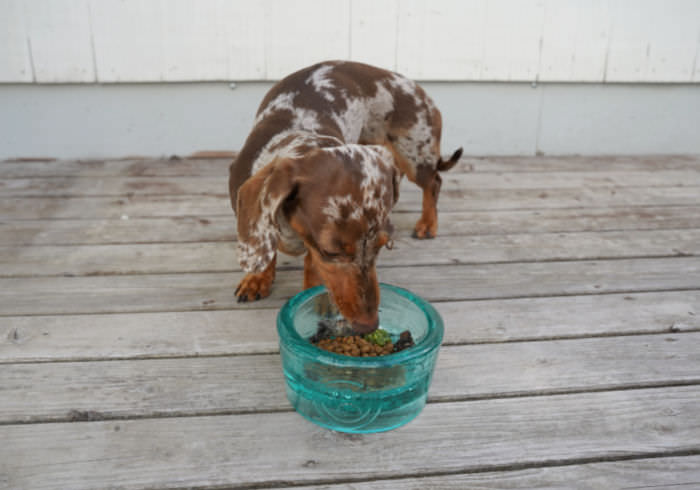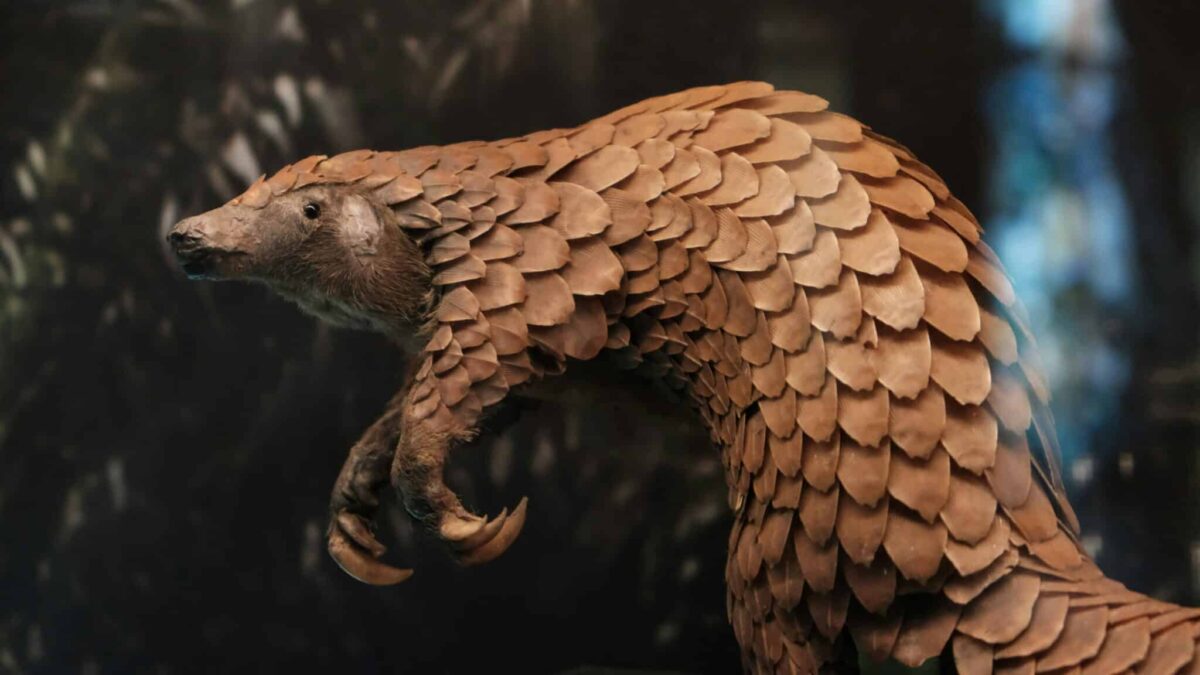Have you heard about the benefits of adding whole, fresh, and raw kibble toppers to your dog’s food?
Are you wondering which kibble toppers to use to enhance your dog’s meal?
Are you curious about how to start feeding raw but feel overwhelmed with all the information?
Let’s look at the benefits that your Dachshund will get by simply topping their bowl with real food.
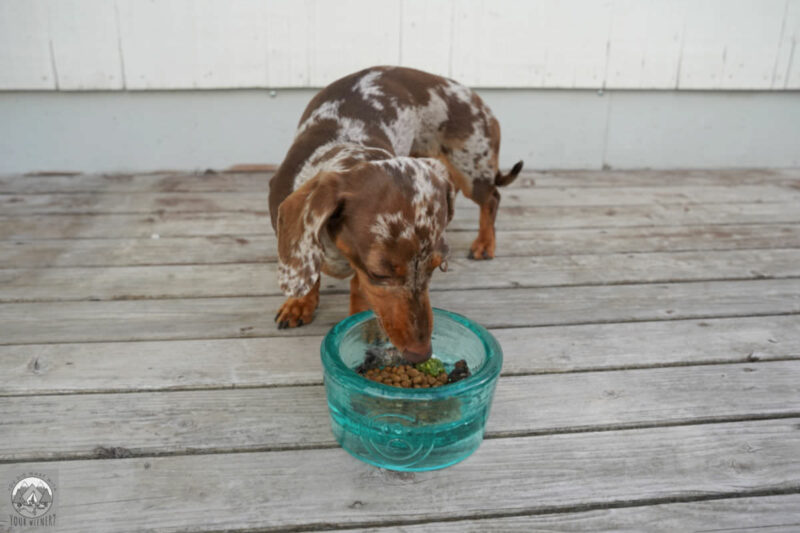
Note: This article is provided in collaboration with Real Dog Box and Kay Stewart, Registered Veterinary Technician. Please see below for Kay’s full bio.
Disclaimer: The links below are affiliate links so we receive a small commission on qualifying purchases.
What Are Kibble Toppers?
“Kibble topper” is a term used to describe anything that you put on your dog’s kibble.
In other words, kibble toppers are the extras you add to your dog’s dish at mealtime in addition to their formulated, processed kibble.
Topping your dog’s kibble with fresh, real food is a great way to help improve your dog’s nutrition without changing diets.
With that being said, many dog parents use kibble toppers as a first step when transitioning to a fully raw diet.
Either way, adding fresh food to kibble will improve some chronic conditions many kibble-fed Dachshunds experience.
Note: many people continue to use meal toppers even when they do feed raw to add additional nutrients and variety.
15 of the Best Dog Food Toppers
Almost anything that is not toxic to dogs, and that is safe for your specific Dachshund based on their heath or ailments, can be used as a kibble topper.
However, there are some common ones with a wide spectrum of benefits.
We cover which benefits each topper provides below, but here is a short list of some of the most popular dog meal toppers.
- Water
- Bone broth
- Raw goat milk or kefir
- Green-lipped or blue-lipped muscles
- Duck feet
- Chicken Feet
- Trachea
- Raw meaty bones (RMBs)
- Eggs
- Muscle meat
- Secreting organs
- Small oily fish (sardines, herring, etc.)
- Fur and feathers
- Dog safe vegetables
- Dog safe fruits
Using kibble toppers, such as raw meat, seafood, organ meat, or bone broth, is an easy starting point if you’ve been curious about feeding your dog a raw but aren’t ready to commit.
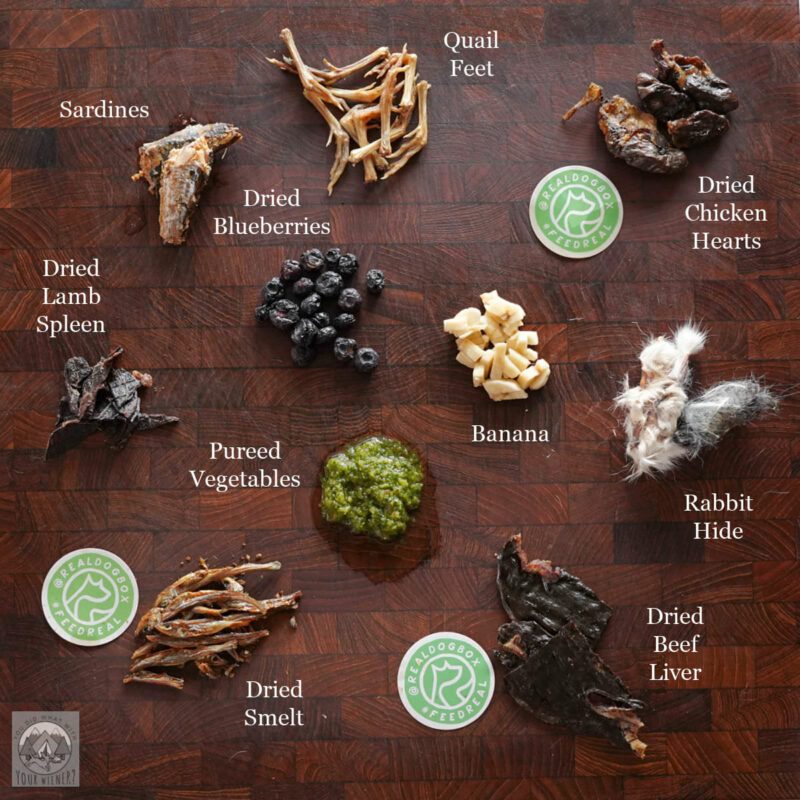
Reasons to Add Kibble Toppers at Mealtime
Dachshunds are prone to several potential health issues.
Feeding the proper diet can help prevent and treat many of these ailments.
Two best things you can do for your Dachshund to help reduce the incidence of disk rupture are to prevent obesity and provide the proper nutrients for general and joint health.
A raw diet comprised of high-quality animal protein and fats will provide your dog with fat rather than carbohydrates as the primary energy source, which will help prevent those extra pounds from expanding your pup’s waistline!
The species-appropriate raw diet does not require the body to overproduce insulin to digest the meal.
By limiting insulin production, fat is not stored by the body but instead used for fuel or energy.
But, you don’t have to feed your dog a raw diet in order to reap the benefits.
Let’s discuss how the appropriate nutrients can affect joint and back diseases, obesity, poor oral health, skin disorders, cancer prevention, liver disease, gastrointestinal tract disorders, and immune system function.
Scroll down to the benefit you want then read which topper is best for it.
Improve hydration
Most kibble contains less than 10{a47be734f0df8d7f120a7df290cf380c79376e8356d1aab405383bb23aa6ce67} moisture, so kibble-fed dogs need continuous access to water.
To help prevent dehydration, constipation, and kidney disease, and to help keep joints well lubricated, you must ensure that your Dachshund gets enough water – approximately 2.5 cups for every cup of kibble.
Simply adding water to your dog’s kibble at feeding time can help keep your pup properly hydrated.
You can also give your Dachshund alternatives to plain water.
Providing flavored liquids like bone broth may encourage your dog eat more of their food.
Bone broth is an excellent nutrient source, and most dogs love it!
You can also add goat kefir to kibble for moisture and to provide vitamins, minerals, and probiotics to enhance your dog’s gut microbiome.
Improve Joint Health
The natural ingredients that help support your Doxie’s joints are glucosamine, chondroitin, and manganese, so choosing kibble toppers that contain these can be beneficial.
Shellfish, such as green-lipped mussels contain glucosamine and blue-lipped mussels contain manganese.
Poultry feet, tracheas, ears, and other cartilaginous body parts provide your pup a natural supply of chondroitin.
Although these items are meal additions, due to the size of your Doxie, you must account for the calories you add with some of these products.
A 20-pound pup needs approximately 350 calories/day.
So, for example, since a duck foot contains 50 calories on average, you need to reduce the portion of other food by that much to accommodate the extra calories.
The mussels are less calorie-dense, so they are safe to provide without concern.
You can give one piece of mussel for every 10 pounds of body weight.
These supplements can be given daily, alternating between the mussels and cartilaginous treats.
Support Oral Health
By two years old, 75-85{a47be734f0df8d7f120a7df290cf380c79376e8356d1aab405383bb23aa6ce67} of dogs have some degree of periodontal disease caused by plaque accumulation.
Periodontal disease is one of the top 5 most common health issues for Dachshunds.
But the plaque or tartar buildup on your dog’s teeth is not your fault!
Plaque forms as the food particles and bacteria stick to your dog’s gum line.
Unlike almost all other mammals, your dog does not have amylase, the enzyme that digests carbohydrates in her saliva.
The dry, hard bits of kibble are loaded with carbs. If there is not enough moisture to rinse all the food away, those carbs end up sticking around and becoming plaque.
Raw meaty bones (RMBs) are excellent kibble toppers or for recreational chewing to improve oral health.
One study found that RMB actually do a similar or better job at reducing oral bacteria than brushing!
RMBs provide natural teeth cleaning and flossing while supplying additional magnesium, iron, manganese, calcium, phosphorus, potassium, sodium, chloride, and sulfur.
While your dog chews on the RMB, they will get much-needed jaw exercise as the gnawing and ripping meat and bones cleans her teeth.
RMBs also offer mental stimulation.
Your pup must chew with all edges of her teeth to remove the meat and tissue from the bones.
Whether using the RMBS as kibble toppers or recreational chews, you can offer them once or twice weekly for optimal oral health benefits.
Choosing the right bone for your Doxie’s mouth is critical.
Chicken and duck feet, whole quail, chicken wings, rabbit feet or heads, or chicken necks are all great options.
Air-dried versions of these RMBs are available from Real Dog Box.
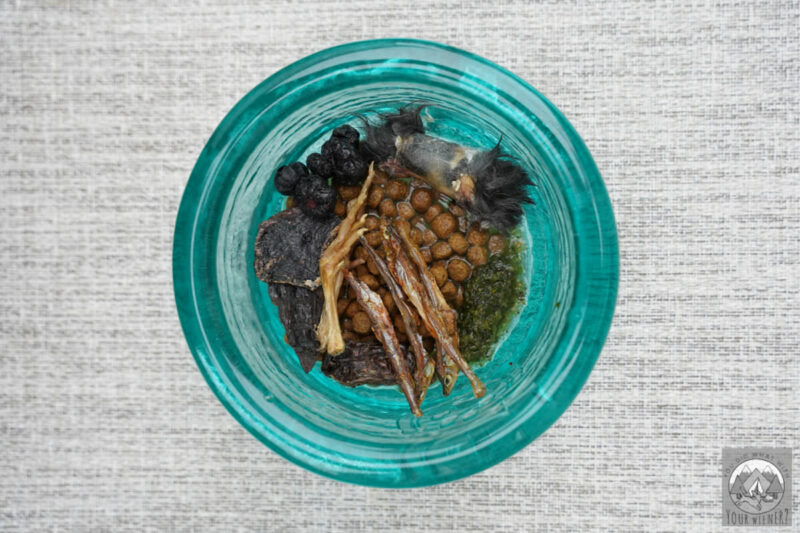
Support Healthy Skin and All Other Body Tissues
Dachshunds are prone to skin disorders.
Two meal toppers that can promote healthier skin are proteins and Omega-3 oils.
Protein is made up of amino acids, the building blocks of all body tissues, so adding it to your dog’s diet provides nutrients to build muscle, body organs, and blood proteins.
This can help them have stronger muscles, have healthier skin, and a thicker hair coat.
You can add oily fish to your dog’s diet for Omega-3 oils, which can help to reduce inflammation throughout your dog’s body.
Kibble is loaded with Omega-6 fatty acids, a promotor of inflammation, so dogs fed kibble tend to have a higher level of these fatty acids in their system than Omega-3 oils..
The imbalance of Omega-3 to Omega-6 ratio can be the cause of your dog’s itchy skin, chronic ear infections, and overall inflammation throughout the body.
So, providing additional Omega-3 oils to balance the ratio can help.
Easy protein and Omega-3 toppers include:
Eggs
You can feed eggs up to 3 times a week for small dogs.
Quail eggs, which are smaller than chicken eggs, may be better suited for your Doxie, especially if you have a miniature breed.
You can serve the eggs raw, scrambled, or hard-boiled.
If available, pasture-raised eggs are the best option because they contain two times more Omega-3 fatty acids, three times more vitamin D, four times more vitamin E, and seven times more beta-carotene than standard eggs.
Meat
Any available muscle meat can be added as a kibble topper but it’s best to use lean, low-fat meats.
You can serve the meat raw or lightly cooked.
Ideally, the meat should come from grass-fed, free-range, and organically-raised animals.
Adding small amounts of fresh meat daily is recommended, but remember to account for the calories of the meat in the total amount of food you feed.
Small Oily Fish
Small oily fish, such as sardines, herring, anchovies, or capelin supply Omega-3, the essential fatty acid that supports healthy skin, brain function, and vision.
For canned fish, make sure it is with water only, with no spices or oils.
For your 20-pound pup, you can add up to ½ ounce of fish daily to their meal to maintain a healthy balance of Omega-3 to Omega-6 fatty acids.
As a kibble topper, fresh, air-dried, or canned fish is better than fish oil because fish oils oxidize very quickly, with oxidation occurring as soon as the bottle is opened or even before!
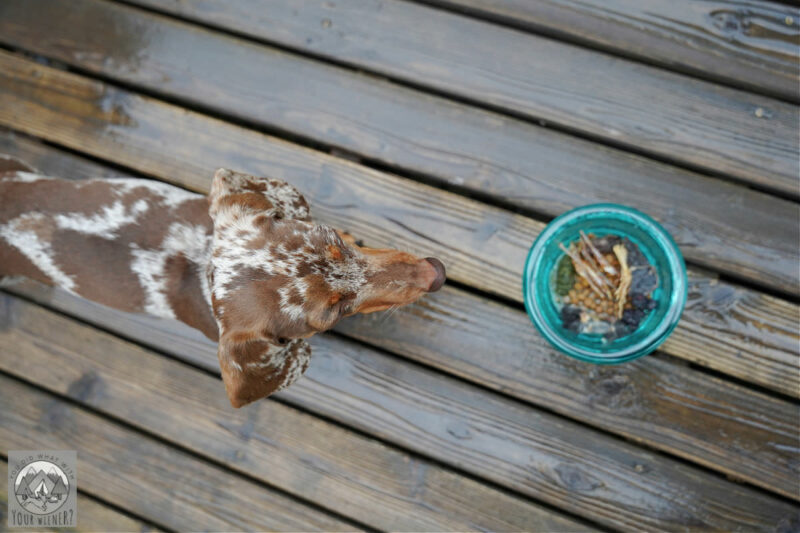
Support the Immune System and Liver Health
Organs are nature’s multivitamin superfood.
But because organs are so rich, you want to ease into adding them to your dog’s meal.
You can use fresh or dried versions of the organs below.
Air dried versions are available through the Real Dog Box Treats and Chews, or chews only, subscription service.
Secreting organs
The typical guideline for raw feeding is 5{a47be734f0df8d7f120a7df290cf380c79376e8356d1aab405383bb23aa6ce67} liver and 5{a47be734f0df8d7f120a7df290cf380c79376e8356d1aab405383bb23aa6ce67} other secreting organs, like kidneys or spleen – as part of your dog’s daily food intake.
If you’re feeding raw organs, for a 20-pound pup, this would be around .025 ounces of each per day.
But if you use organs only as a kibble topper, you should feed half of that amount to avoid vitamin toxicity.
You can find many organ meats in dried form, usually available as treats.
Look for single-ingredient organ meats and start with a few small pieces, totaling no more than the size of your dog’s paw.
Muscle organs
The lung, heart, gizzards, and tripe (intestine) are called organs but are classified as muscle meat in raw feeding because of their function.
When feeding these organs, consider them muscle meat when adding them to your dog’s bowl (see the “meat” section above).
The toppers should not exceed 10-20{a47be734f0df8d7f120a7df290cf380c79376e8356d1aab405383bb23aa6ce67} of your dog’s daily food intake.
Improve Gut Health
Fiber has so many health benefits for your Dachshund, including weight control, decreased risks for cardiovascular disease, diabetes, and cancer, and providing essential gut microbiome nutrients to function correctly.
Dietary fiber can also reduce chronic inflammation throughout the body, thus impacting all areas of your dog’s overall health and well-being.
Below are some kibble toppers that will add fiber to your dog’s meal.
Fur and Feathers
Fur and feathers are excellent sources of fiber for dogs, especially those that will not eat vegetables!
Because fur contains cellulose, it aids in the digestion of food, allowing it to pass through the digestive system more efficiently, which aids in preventing constipation in dogs and reduces the risk of bloat.
Other benefits of fur consumption include maintaining blood sugar levels, providing vitamin B12, which aids in cognitive ability, and providing manganese, which aids in joint and ligament health.
Although fur is found in kibble as whole animals are processed in the rendering plant, it does not have the same benefits as natural fur due to the high heat processing of the rendered materials.
Give your pup a fur-on treat, such as rabbit ears, feet, quail, small chickens, and cow ears, one to two times weekly.
You can get these feathery and furry chews in a Real Dog Box monthly subscription box or from the Secret Shop.
Vegetables
Recent studies show that 60{a47be734f0df8d7f120a7df290cf380c79376e8356d1aab405383bb23aa6ce67} of dogs will eventually develop cancer.
Adding leafy greens as a kibble topper just three times a week has been shown to reduce the risk of cancer by 90{a47be734f0df8d7f120a7df290cf380c79376e8356d1aab405383bb23aa6ce67}!
For those dogs that will eat vegetables, the benefits include improved digestion, providing nutrients to the gut microbiome, vitamins, minerals, and anti-cancer agents.
You can feed vegetables daily, but starchy vegetables like peas and corn should be kept to a minimum.
Veggies can make up 3-5{a47be734f0df8d7f120a7df290cf380c79376e8356d1aab405383bb23aa6ce67} of a dog’s raw food bowl or as kibble toppers.
Please note that the dog’s digestive tract is not equipped to absorb nutrients from many vegetables whole and unprocessed.
You can feed the following vegetables raw: alfalfa sprouts, arugula, asparagus, basil, carrot tops, celery, dill, peas, kelp, mint, red lettuce, romaine lettuce, seaweed, spring greens, sprouted seeds, and wheatgrass.
Vegetables that should be blended or pureed before feeding include green beans, radishes, rainbow chard, red beets, and zucchini.
Broccoli, brussels sprouts, cauliflower, and kale are goitrogenic, inhibiting the body’s ability to use iodine so, although these vegetables are very nutritious, do not feed them to hypothyroid dogs.
You must cook starchy vegetables such as carrots, mushrooms, pumpkin, squash, sweet potatoes, and yams to allow for digestion.
Again, limit the amount of these vegetables to prevent weight gain.
Fruits for Antioxidants
Fruits provide antioxidants severely lacking in kibble because of the extreme heat processes used for manufacturing.
Fruits also contain phytonutrients, minerals, and vitamins.
Berries are the best fruit to feed dogs because they have high water content and are sweet, making them so enticing to dogs.
Safe berries to include as kibble toppers or as treats are blueberries, raspberries, strawberries, and blackberries.
Bananas are best fed when still slightly green because they contain less sugar.
The green fleshy fruit of the avocado is also an excellent topper for its Vitamin C, E, potassium, folate, and fiber.
The avocado flesh also contains β-sitosterol, which improves heart health!
Note: The avocado leaves, bark, and skin are toxic to dogs but not the flesh/pulp inside. However, it is high in fat so feed it only in small amounts or don’t if your dog needs to eat a low-fat diet (source).
Never give grapes or raisins, as both are toxic to dogs.
Although not toxic to dogs, you should also avoid feeding citrus fruits, like lemons, limes, oranges, grapefruit, and cherries, because of their high sugar content, and they can cause gastrointestinal issues.
Remember, fruits and other fibers should not exceed 5{a47be734f0df8d7f120a7df290cf380c79376e8356d1aab405383bb23aa6ce67} of your dog’s diet. Minimal use for treats and toppers is recommended.
Pro tip
if you’re new to feeding raw toppers and chews:
- Start Slow
- Be mindful of portion size
- Supervise while chewing
- Understand the risks
How Much Kibble Topper Should I Add?
There are varying opinions on how many toppers to add to the kibble-based diet.
The one thing everyone can agree on is that the kibble toppers must be accounted for in the total daily caloric intake of the dog.
However, the basic advice for amount of kibble topper is to only replace 10-20{a47be734f0df8d7f120a7df290cf380c79376e8356d1aab405383bb23aa6ce67} of the diet with whole fresh food.
But a lot of kibble toppers were mentioned in this article and you may be wondering how to incorporate most or all of them without exceeding the above guideline.
First, remember that you don’t need to use all of the toppers on this list. Supplement with purpose!
Some provide overlapping benefits, and your dog may not benefit from some, so pick and choose which ones you want to feed your dog.
For example, add fresh fish can help reduce inflammation, which can help reduce allergy symptoms, dry skin, and provide joint support.
Also, you don’t have to add all of the toppers to each meal.
You can add some to breakfast time and different ones to your dog’s dinner.
Or, if you want to use a lot of kibble toppers, you can add different ones to the bowl each day of the week.
Your dog will still get benefits even if a topper is only added a couple times a week.
In fact, that is recommended with some foods (like eggs – only 3 times a week).
Using Kibble Toppers to Transition to a Raw Diet
Some people use kibble toppers to transition their Dachshund to a raw diet.
In this case, the raw “topper” percentage increases over time until the meal is composed of all fresh, raw ingredients.
For example, for the first couple weeks, the topper may only comprise 10{a47be734f0df8d7f120a7df290cf380c79376e8356d1aab405383bb23aa6ce67} of your dog’s meal.
Over time, this ratio will increase so that midway through the transition your dog would be eating 50{a47be734f0df8d7f120a7df290cf380c79376e8356d1aab405383bb23aa6ce67} fresh, raw food and 50{a47be734f0df8d7f120a7df290cf380c79376e8356d1aab405383bb23aa6ce67} kibble.
Do note if you are using raw food to transition from kibble, due to the differences in the stomach acid pH for a high carbohydrate diet and a fresh protein-based diet, once the percentage of whole food is 50{a47be734f0df8d7f120a7df290cf380c79376e8356d1aab405383bb23aa6ce67} or more, it is best to split the meals.
The kibble portion can be fed as the morning meal and the fresh food as the evening meal.
Then, since the evening meal would become 100{a47be734f0df8d7f120a7df290cf380c79376e8356d1aab405383bb23aa6ce67} raw, fresh food, you would start changing the ratio of the morning meal of kibble.
Eventually, your dog’s entire diet would be constituted of raw food.
For more information about transitioning your dog to a new food, read How to Switch Dog’s Food The Right Way.
Do be aware that creating a nutritionally-balanced raw food diet for your dog is crucial so a nutrient deficiency doesn’t develop, potentially resulting in illness, hair loss, muscle loss, or lose teeth.
So, if you are new to raw, be sure to consult with a dog nutritionist familiar with a proper raw diet or use a commercially-prepared raw formulation.
The meal toppers can still be used if you are feeding raw to add bonus nutrients and variety.
Final Thoughts: The Role of Kibble Toppers
The role of kibble toppers is identical to the components of the raw diets but supplied in smaller portions.
If you want to improve your Dachshund’s diet but are concerned with balancing a homemade raw diet, or with handling raw meat, it’s ok to stick with kibble.
But you can enhance this diet, and your dog’s health, by adding whole-food kibble toppers to your dog’s meal.
Providing 10-20{a47be734f0df8d7f120a7df290cf380c79376e8356d1aab405383bb23aa6ce67} of your Dachshund’s meals as these toppers is enough to provide significant health advantages for your dog.
Remember to supplement with purpose! Review this list and decide which toppers you want to give your dog based on the benefits.
You can then rotate these toppers daily or weekly in accordance with prefrence and feeding guidelines.
However, be warned! Many dogs will start to leave the kibble uneaten, preferring the raw components.
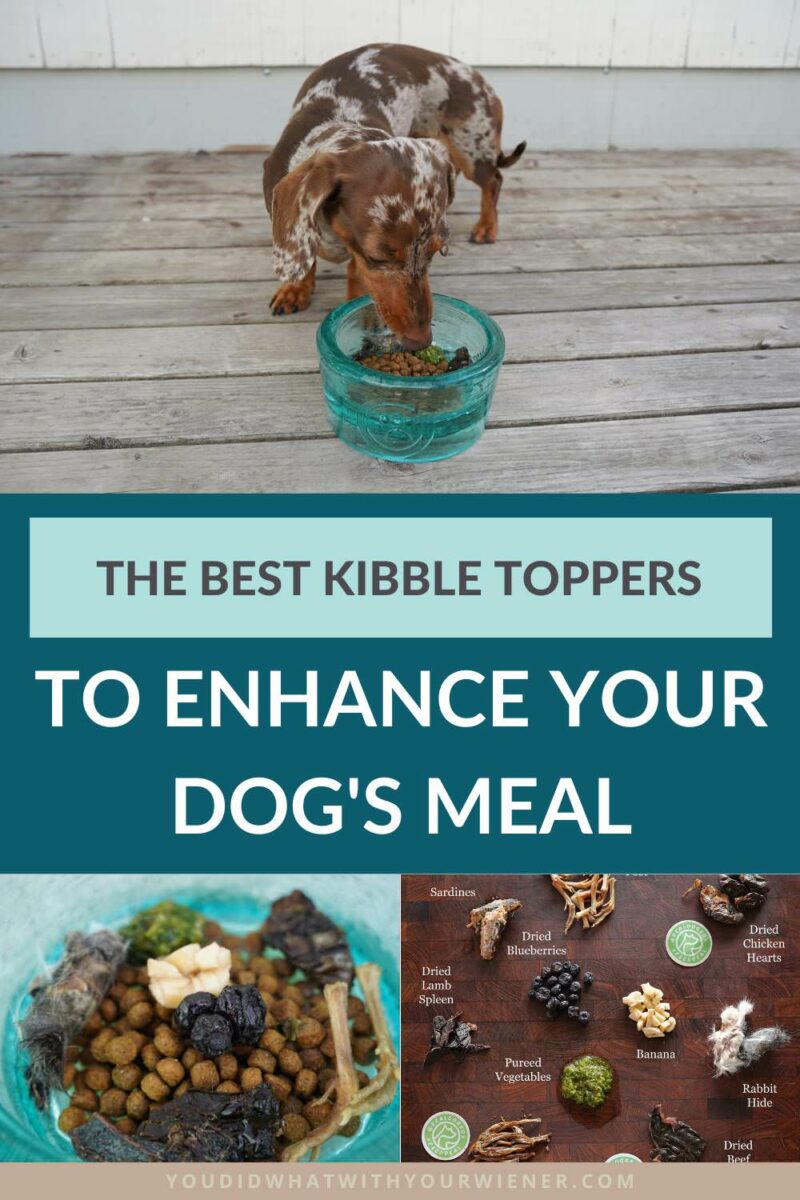
Article Collaborator: Kay Stewart, a Registered Veterinary Technician certified in Canine Nutrition through the Feed Real Institute, Companion Animal Science Institute, and North America Veterinary Community. Kay received her degree in veterinary technology at Purdue University, spent 32 years of her career in biomedical research at the University of Notre Dame, and is a published author.
References
Brady, C. (2020). Feeding dogs dry or raw? The science behind the debate. Farrow Road Publishing.
Offal Chemical Composition from Veal, Beef, and Lamb Maintained in Organic Production Systems – PMC
Health-Promoting Phytonutrients Are Higher in Grass-Fed Meat and Milk | Sustainable Food Systems
Fishing for answers: is oxidation of fish oil supplements a problem? – PMC
Research shows eggs from pastured chickens may be more nutritious | Penn State University
A review of fatty acid profiles and antioxidant content in grass-fed and grain-fed beef

